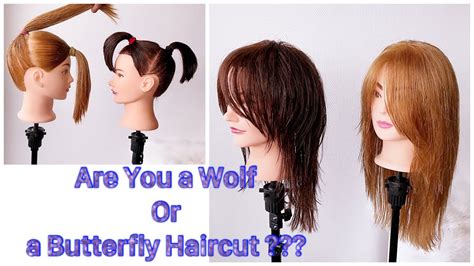Introduction
The wolf cut and butterfly cut are two popular layered hairstyles that have garnered significant attention in recent years. While they share some similarities, these hairstyles differ in their overall shape, volume, and styling techniques. This article provides a thorough comparison of the wolf cut and butterfly cut, exploring their key characteristics, benefits, and potential drawbacks.

Section 1: Wolf Cut
Understanding the Wolf Cut
The wolf cut is characterized by its shaggy, layered silhouette that resembles the mane of a wolf. It typically features:
- Graduated layers throughout the hair, creating a triangular shape
- A blunt or choppy fringe that frames the face
- Volume at the crown and nape, with reduced volume at the mid-lengths
- A messy, textured finish that adds a touch of rebellion
Benefits of the Wolf Cut
1. Versatility: The wolf cut suits a wide range of face shapes and hair textures, from straight to wavy and curly.
2. Low Maintenance: It requires minimal styling effort and can be easily air-dried for a natural look.
3. Edgy Appeal: The wolf cut exudes a cool and edgy aesthetic that appeals to those seeking a bolder style.
Drawbacks of the Wolf Cut
1. Potential Frizz: The layered structure of the wolf cut can increase the likelihood of frizz in humid environments.
2. Regular Trims: Frequent trims are necessary to maintain the shape and texture of the wolf cut.
Section 2: Butterfly Cut
Grasping the Butterfly Cut
The butterfly cut is a layered hairstyle that mimics the delicate wings of a butterfly. It features:
- Layers that flare out and curve inward, creating a “butterfly wing” effect
- A soft, feathered fringe that blends seamlessly with the rest of the hair
- Volume concentrated around the cheekbones and ears, with less volume at the back
- A sophisticated, feminine finish that evokes grace and allure
Advantages of the Butterfly Cut
1. Flattering Shape: The butterfly cut frames the face beautifully, accentuating cheekbones and softening facial features.
2. Volume and Movement: The carefully placed layers create the illusion of volume and movement, making it a good choice for fine or thin hair.
3. Effortless Styling: The butterfly cut requires minimal styling and can be easily styled with a blow dryer and round brush.
Disadvantages of the Butterfly Cut
1. Higher Maintenance: Regular trims and blowouts are essential to maintain the shape and volume of the butterfly cut.
2. Suitable for Certain Hair Types: The butterfly cut works best on straight or slightly wavy hair; it may not be suitable for curly or coarse hair.
Section 3: Wolf Cut vs Butterfly Cut: Key Differences
| Feature | Wolf Cut | Butterfly Cut |
|---|---|---|
| Layering Pattern | Graduated layers with a triangular shape | Curved layers with a “butterfly wing” effect |
| Volume | Concentrated at the crown and nape | Concentrated around the cheekbones and ears |
| Texture | Messy, textured finish | Soft, feathered finish |
| Styling | Minimal styling, air-drying possible | Regular blowouts and trims required |
| Maintenance | Low maintenance, frequent trims | Higher maintenance, regular trims and blowouts |
Section 4: Choosing the Right Style for You
Considerations for Selecting the Wolf Cut
- Those seeking an edgy, rebellious look
- Individuals with all face shapes and hair textures
- Individuals open to minimal styling and regular trims
Considerations for Opting for the Butterfly Cut
- Those seeking a sophisticated, feminine hairstyle
- Individuals with straight or slightly wavy hair
- Individuals willing to commit to regular styling and maintenance
Section 5: Common Mistakes to Avoid
Wolf Cut Mistakes:
– Cutting layers too deep, resulting in a mullet effect
– Over-using texturizing products, leading to excessive frizz
– Neglecting regular trims, compromising the shape of the cut
Butterfly Cut Mistakes:
– Cutting layers too wide, creating a flat and unflattering shape
– Blow-drying the hair straight, losing the distinctive butterfly wing effect
– Skipping trims, allowing the layers to become overgrown and heavy
Section 6: How to Style the Wolf Cut and Butterfly Cut
Wolf Cut Styling Technique
- Air-dry the hair or blow-dry using a diffuser to enhance texture.
- Use a pomade or wax to create separation and definition.
- Tease the crown slightly for added volume.
- Run your fingers through the hair to create a messy, effortless look.
Butterfly Cut Styling Technique
- Blow-dry the hair with a round brush, curving the layers inward to create the butterfly wing effect.
- Use a volumizing spray to boost volume at the roots and cheekbones.
- Finish with a light hairspray to hold the style in place.
- Use a shine serum to enhance the soft, feathered finish.
Section 7: Conclusion
The wolf cut and butterfly cut offer distinct and alluring hairstyles with their unique layered structures and styling techniques. Understanding the key differences between these styles allows individuals to make an informed choice that aligns with their personal preferences, face shape, and hair texture. Whether seeking an edgy and rebellious look or a sophisticated and feminine style, the wolf cut and butterfly cut provide versatile options to enhance one’s appearance and express their individuality.
